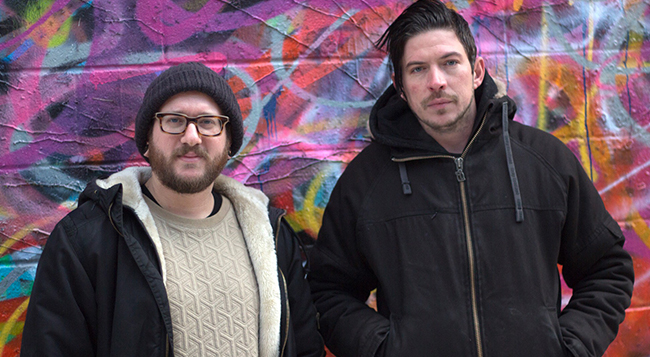Germ, left, and JOP! Image via Connor McHugh
Philadelphia isn’t the most weed-friendly city, but it is home to one of the most forward-thinking and creative glassblowing communities in America. On a single block on Front Street in North Philly sits a warehouse where you can find five distinct studios and one gallery stocked with borosilicate glass, kilns, and several of the headiest artists making the headiest pipes and oil rigs available to purchase.
Veteran glassblowers Germ (Jeremy Grant-Levine) and JOP! (Josh Opdenaker) are two such artists who create there. Over the last 15 years, each turned their personal passions into a thriving career. Both got into the craft in the early aughts when there was no money to be made selling glass (“That’s the story of our entire industry, being broke for the first several years,” says Germ), but they kept at it, and they now sell their next-level wares to people all across the country, including rappers Wiz Khalifa and Redman.
This past year, JOP! got into making anatomically-inspired heart pipes and also used his glass wizardry to spawn a 3-foot-tall, six-armed “Baby Mecha Ganesh” hash oil rig, valued at $100,000. Germ impressively crowdfunded $92,000 for a glass crane sculpture project he’s currently in the thick of. MERRY JANE spoke to the glassmen to learn more about what it’s like to make mind-blowing (and mind-expanding) smoking devices for a living, what makes Philly’s glass community so special, and how legalization and other factors are affecting the industry.
Heart bubbler, by JOP! Image via JOP!
MERRY JANE: Both of you have been working with glass for years. How has the glassblowing game changed?
Germ: For one, the push for legalization has made glass a lot more acceptable. There are a lot of people making a lot of black-market money, and, luckily for us, they’re putting it into our industry. The rise of hash oil has made a huge impact in our industry because you have to have a piece to smoke oil. You can use a pen, but when oil first started becoming popular, the only way to consume it was glass. I remember seeing oil back in the day, like, late ’90s, early 2000s, but there was no way to consume it. I don’t think it ever became popular, but the hash oil and glass oil rig market grew together.
JOP!: Social media had this huge influence because, with the push of a button, you can reach thousands of people. Ten years ago, you had to spend time making the pipes, but you also had to spend time driving around the country trying to sell those pipes to stores, person to person. With social media, I just press a button, upload a picture, and I can sell a pipe without even leaving my studio.
G: Back in the day, we had to work a month without getting paid, load the car up with pipes, and then make ridiculous road trips where we’d cold-call head shops. I’d often spend an hour or two at a shop without selling a goddamn thing. One year, when I was so broke, I went up to New York City and went around lower Manhattan to all the head shop and tattoo shops with three cases of glass strapped to my back. It was freezing cold and I went into close to 40 shops. I think I sold three pieces to one store in that whole fucking day.
A piece from the “Smoke on the Water” series, by Germ. Image via Jeff DiMarco
Head shops with glass pieces have been around forever. What sparked glass connoisseurship, with people spending thousands of dollars on pieces and starting collections?
G: You find that kind of connoisseurship in anything, whether it’s glass pieces, fashion, or cars. People take things to the extreme no matter what. Luxury goods are luxury. The luxury market for pipes has always been there, and people have been willing to buy crazy headpieces. But, through social media, it’s become public. It was never at the flex-game that it’s at now. It was much more private before, and glassblowers had more of a relationship with those customers. Today, we live in this “look at me, look at me, look at what I got” society because we’re so visual, we’re so image-based.
J: Another reason—and part of why pipes are so cool—is that if a connoisseur buys a painting, it just stays on the wall and you observe it. That’s cool, but with a pipe you have an interaction that happens: You get high off of it. So, it’s something you observe and also something that changes your mind-state, physically. That appeal and functionality is what drives people to spend large money on pipes.
The “Baby Mecha Ganesh,” by JOP! Image via JOP!
With five studios and a gallery in your Philly space, what’s the dynamic like between the artists? What are the pros and cons of being around other serious glassblowers?
J: Philly is unique in that it’s not competitive. We all try to elevate each other. I’ve been in other cities in this country where everyone is trying to knock each other down. But, here in Philly, everything is so rough that we all stick together and push each other up. The con of it is that there’s always somebody down to go out drinking. [Laughs.] There are a decent amount of distractions.
G: Also, we don’t have a huge local market in Philly. We’ve never scrapped over the same accounts, and we all had to be real creative with getting our work out there. I came up just behind Josh and [Philadelphia glassblowers] Nate Purcell and M. Slinger. They were always this model for me to look up to. They were doing all these big things together, and their camaraderie set a tone for everyone else who came up in the city after them. They set this example of professionalism, concept, and quality that wasn’t necessarily being represented in other cities, and definitely not being represented as a team or as a crew like it was in Philly. As a second-generation Philly pipemaker, I had that to emulate, and they set a certain precedent for that. Everyone who’s come after me has honored that style. The city really does have something special about it.
“Ill-uminati,” a Germ collaboration with Mr. Voorhees. Image via Jeff DiMarco
Pennsylvania’s not the most weed-friendly state, so that sense of a glassblowing community is interesting.
G: The nice thing about Philly that maybe comes out of that is that there’s a really vibrant art community here, but not necessarily a vibrant weed community. We’re not always running just within our own circles. The people we interact with are other artists, often in other mediums, other galleries, other gallerists. A lot of the people we hang out with aren’t necessarily weed people. We’re always getting influences from other places and markets, too, and you can see that in a lot of the work that comes out of Philly. We’re not self-referential, we’re not only influenced within the pipe, glass, and weed communities.
J: Also, when we all started, there was no money in pipes. The only reason you were making pipes was because you truly loved it. We all bonded because of that. And now that there’s money in it, there’s a bunch of fuckery that’s attached to that. For example, people who try to make pipes just because they think they’re gonna make a lot of money, not because they actually love it. But our core group, everyone on this block, is on the same level. Everybody does it because they love it, and everybody works their ass off. That’s another reason why we bond: Nobody slacks around here. Everybody grinds hard. It’s like the modern-day Warhol Factory. We have Warhol’s Factory, but it’s on a block and we make pipes. [Laughs.]
“Made You a Mixtape,” by JOP! Image via JOP!
How do you think the legalization of recreational marijuana in all these new states could benefit or even hinder the glass industry?
J: Well, the market is already oversaturated, 100 percent, no doubt. Also, the release of Slinger’s movie on Netflix, Degenerate Art, helped create new pipemakers. It just blew pipes out of the water. Quite frankly, you don’t need a lot of money to start a pipemaking studio. It’s an achievable amount of money for anybody of any economic background; it can be attained. So, now you have these kids at home who watch this movie and they’re like, “I want to do that,” and they totally can do that. Before that, there were a couple thousand glassblowers and everybody knew each other. After Degenerate Art dropped [in 2012], there were so many pipemakers that the market got saturated, and now I barely know anybody, I feel.
G: I haven’t thought about what will change once weed is legalized in more states because we’ve been doing this shit since weed was outlawed. In my mind, it’s like, bring it on. No matter what, I’m going to find a way to [continue glassblowing]. I’m not scared.
J: We’re both versed in doing this and being broke. A lot of these kids who are making a lot of money right now don’t know what it’s like to be able to do this on a shoestring budget, whereas me and Germ are really versed in that. So, if the money runs out next year, which it won’t, we’ll still be there.
“William S. Burg,” a Germ collaboration with Slinger. Image via Jeff DiMarco
Are there any innovations that you’d like to see in the glass game?
G: I don’t give a fuck about innovation. I care about artistry. That’s just me personally. I know that there will be boundaries to push as far as artistry and creativity goes. I don’t care where the technology goes, I don’t care where the innovation goes, I don’t care if someone discovers a new way to spin water around in a recycler that everybody fucking loves. For me, I just love seeing all my friends push concepts and push boundaries. This material that we use called borosilicate glass was an industrial material, not an artistic medium, until pipemakers started fucking with it about 20 years ago. The boundaries are endless. I see my friends on this block do things with this material that I was taught in school that it should not be able to do. I see people break the rules every day, and all these people pushing the boundaries and breaking the rules are doing it out of artistry.
J: Every so often, there are trends within this game. There are hype trends that happen, and the majority of people follow those. But, people in Philly don’t follow the trends—they’re making them.











